Is Embedded Analytics Ushering a New Wave in Healthcare?
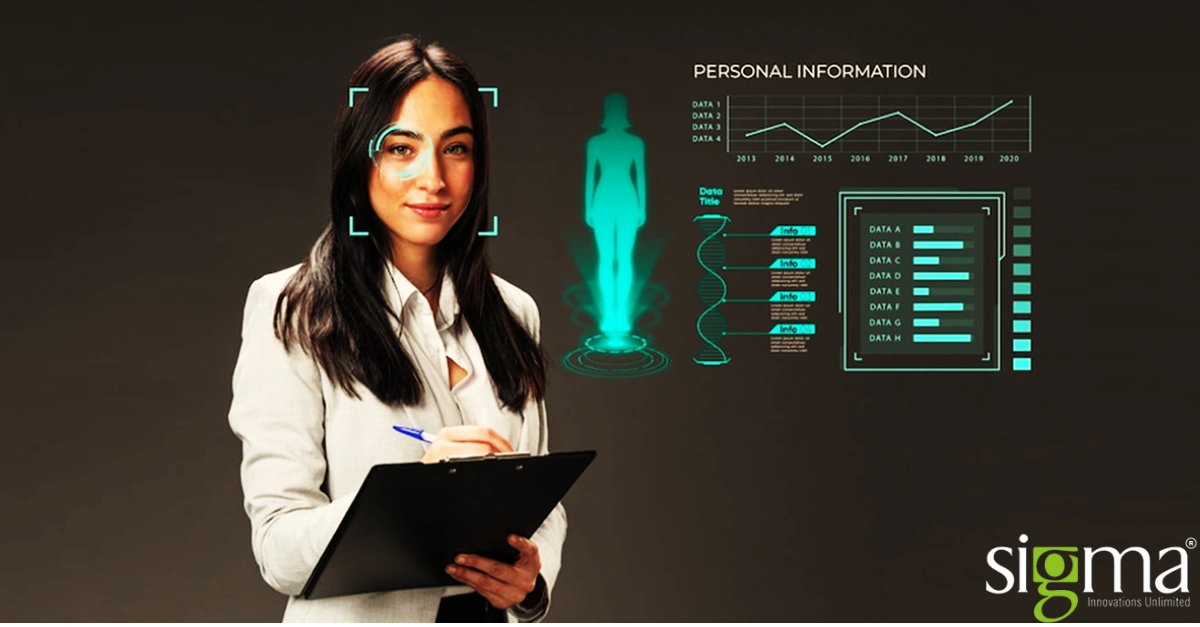 The healthcare industry isn’t what it used to be—not even close. Gone are the days when patient files lived in dusty cabinets and decisions were made on gut feeling alone. Today, with the push for patient-centric care and tighter data regulations, healthcare providers are racing toward digital transformation. And leading this charge? Embedded analytics.
The healthcare industry isn’t what it used to be—not even close. Gone are the days when patient files lived in dusty cabinets and decisions were made on gut feeling alone. Today, with the push for patient-centric care and tighter data regulations, healthcare providers are racing toward digital transformation. And leading this charge? Embedded analytics.
Think of it like giving doctors, healthcare providers, insurance companies, and admins a smart assistant that lives inside their everyday tools. Whether it’s tracking patient outcomes or spotting trends in billing, embedded analytics solutions promise real-time insights right where they’re needed—without switching between a dozen dashboards.
But as with all tech, it raises a big question: Is this innovation a real game-changer or just another shiny tool that creates more problems than it solves?
As a Technology Services company working across industries, we’ve seen the rise of embedded data analytics and how it’s reshaping operations. The global embedded analytics market was valued at USD 19.80 billion in 2024 and is projected to reach USD 22.93 billion in 2025, growing at a CAGR of 18.4% from 2025 to 2032. This surge reflects a growing demand across sectors, especially in healthcare, where data-driven insights are critical. Around 66% of US healthcare providers have already embraced predictive analytics, a key component of business intelligence (BI). As embedded analytics becomes increasingly integrated into clinical and operational systems, it’s no longer optional—it’s imperative for success. In this blog, we’ll explore both sides of the coin—whether embedded analytics tools are truly a boon or a bane for healthcare organizations.
Let’s break it down.
What Is Embedded Analytics—and Why It Matters for Healthcare Platforms
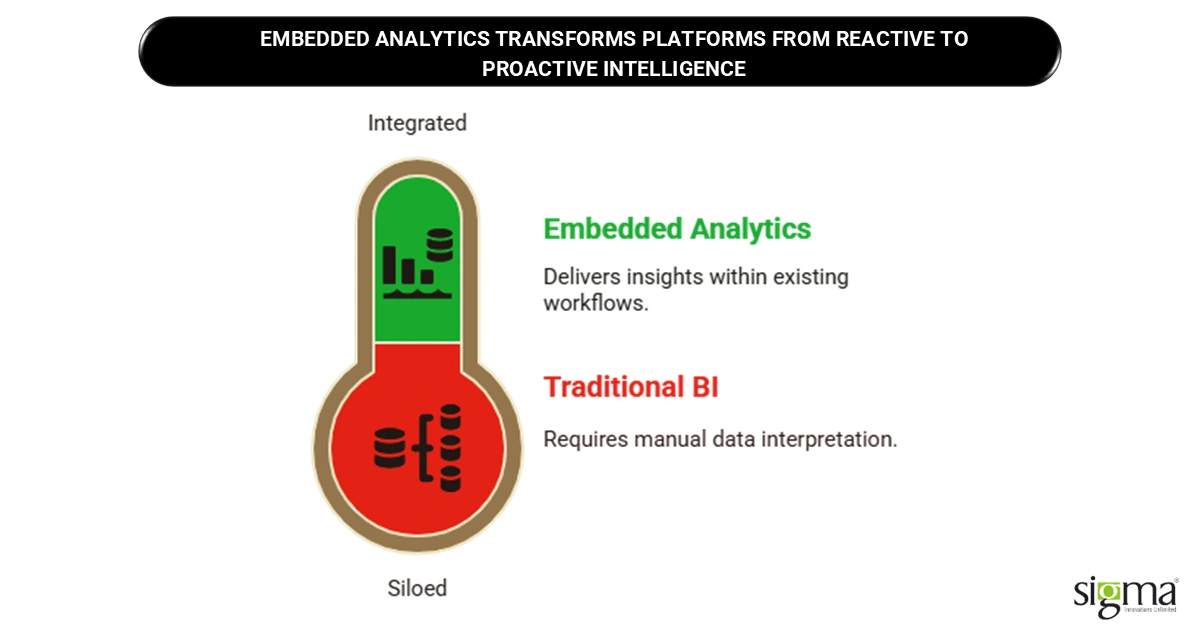
So, what is embedded analytics, really?
In simple terms, embedded analytics means integrating powerful data analysis tools directly into the software people already use—no more jumping between five different tabs or tools. In the healthcare world, that could be patient portals, mobile health apps, Electronic Health Records (EHRs), or insurance systems. Instead of logging into a separate BI dashboard, the insights you need are baked into the platform.
Compare that to traditional systems, where reports live in siloed systems. Healthcare pros would waste hours toggling between platforms, pulling reports, and interpreting raw data. Not only is that time-consuming, but it also creates a gap between data and action. However, this has changed with the advent of modern-day BI and analytics development services.
With embedded analytics solutions, modern healthtech platforms are flipping the script. Imagine a doctor seeing real-time patient risk scores inside the EHR or an insurance agent reviewing claim anomalies right within their workflow. That’s the power of embedded data analytics—insight without interruption.
If this sounds familiar, that’s because FinTech’s been doing it for years. From embedded credit scoring to real-time KYC dashboards, financial apps now serve insights inside the user experience. The healthcare sector is catching up, and fast.
As technology development services providers with experience across the industries, we’re seeing firsthand how embedded analytics tools are transforming platforms from reactive systems to proactive intelligence engines.
And that’s a game-changer.
Also Read: Current State of Embedded Analytics and Its Advantages
Key Healthcare Use Cases Enabled by Embedded Analytics
Embedded analytics isn’t just a buzzword—it’s showing up in real ways across the healthcare space. From hospital floors to mobile apps, embedded analytics solutions are delivering insights where and when they matter most. Let’s break down some of the top use cases that are transforming modern healthcare platforms.
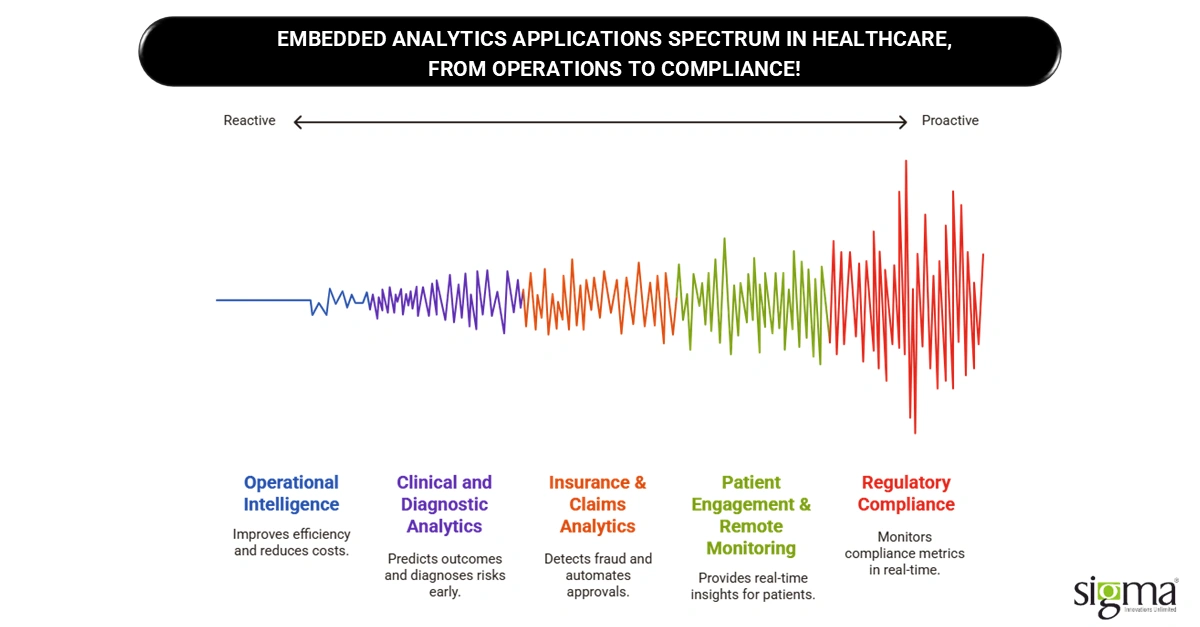
Operational Intelligence
Picture this: a hospital’s ICU beds are filling up fast, devices are scattered across departments, and nurses are stretched thin. Now imagine an embedded data analytics dashboard that shows real-time availability of beds, flags underused equipment, and helps schedule staff more efficiently—all within the tools the admin team already uses.
This is operational intelligence powered by embedded analytics tools. By making data visible in daily workflows, hospitals are cutting costs, reducing wait times, and improving care delivery without needing additional staff.
Clinical and Diagnostic Analytics
Healthcare providers are now using predictive models to spot early warning signs—sometimes before a patient even walks through the door. These models, embedded directly in Electronic Health Records (EHRs) and diagnostic platforms, use AI-driven algorithms to predict treatment outcomes and diagnose risks.
Think of it as a digital crystal ball. By blending Artificial Intelligence with embedded analytics, clinicians get timely alerts for sepsis risk, medication responses, or chronic illness progression—right where they’re documenting patient care.
Insurance & Claims Analytics
This is where things get interesting, because the line between FinTech and HealthTech is blurring. Insurance companies are using embedded analytics solutions to detect fraud, generate real-time policy pricing insights, and automate pre-authorization approvals.
Just like in finance, where embedded credit scoring happens inside loan platforms, health insurers now benefit from embedded analytics tools that flag suspicious claims or help underwrite smarter policies. It’s efficient, secure, and saves millions in unnecessary payouts.
Patient Engagement & Remote Monitoring
Modern healthcare isn’t confined to clinics. With the rise of wearables, mobile apps, and IoT devices, healthcare manufacturers and health tech companies are gathering vast amounts of patient-generated data. But raw data alone isn’t helpful—it needs context. That’s where embedded analytics comes in, enabling these B2B innovators to precisely understand user behavior, personalize experiences, and deliver better outcomes.
That’s where embedded analytics steps in. Think real-time dashboards inside a diabetes management app or heart-rate trend analysis from a smartwatch feeding into a doctor’s system. These aren’t just cool gadgets—they’re lifesaving tools, powered by IoT software development and smart analytics.
Regulatory Compliance
Compliance in healthcare is no joke. With HIPAA, CMS, and state-level mandates, even a small slip-up can be costly. But thanks to embedded analytics, healthcare enterprises can now monitor compliance metrics in real-time—helping businesses stay ahead of regulatory risks.
Automated audit logs, alerts for data breaches, and easy-to-export reports are built into clinical software, keeping healthcare providers in the clear. Whether it’s HIPAA or CMS reporting, embedded analytics tools help stay on top of it—without the paperwork nightmare.
From the frontlines of care to the back office, embedded analytics is proving its value. And when combined with smart technology consulting services, Salesforce services, or advanced tech consultancy service strategies, the possibilities only grow.
Also Read: Salesforce Spring ’25: Game-Changing Updates for Developers
Why Embedded Analytics Is a Boon: Business and Tech Advantages
When you look under the hood of today’s top healthtech platforms, one thing becomes clear: embedded analytics isn’t just a fancy feature—it’s a powerful driver of smarter decisions, smoother operations, and stronger ROI. Whether you’re building digital health tools or managing a large hospital network, the benefits of embedded analytics solutions are hard to ignore.
Let’s break it down by stakeholder.
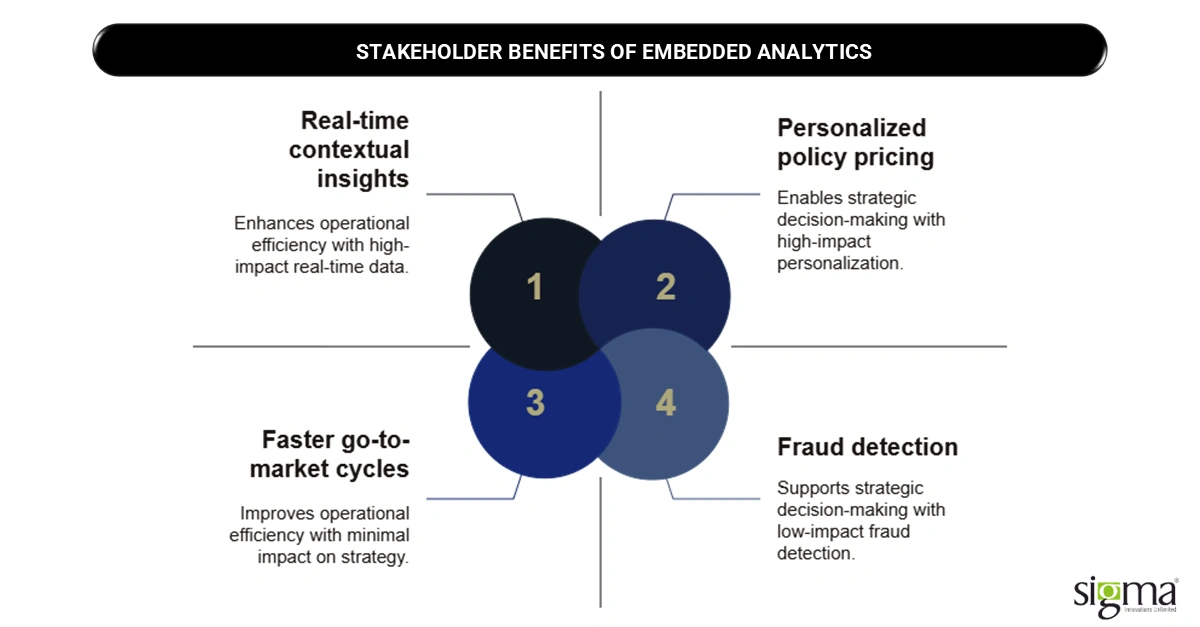
For Product Teams of HealthTech Companies
Building analytics features from scratch can be a drain on time, money, and dev bandwidth. That’s why product leaders are turning to embedded analytics tools with pre-built dashboards, data models, and visualizations.
Instead of reinventing the wheel, dev teams can integrate these tools into SaaS apps with minimal friction. The result? Faster go-to-market cycles, lower costs, and a better user experience. And when backed by expert BI & analytics development services, these platforms scale effortlessly across user bases.
For CTOs
CTOs love solutions that don’t break under pressure. With cloud-native embedded analytics, healthcare platforms can easily scale to handle growing volumes of patient, claims, and device data.
Thanks to out-of-the-box integrations with AWS, Azure, and Snowflake, analytics features no longer sit on fragile, monolithic codebases. Instead, they tap into modern architectures that support real-time data processing, advanced Artificial Intelligence, and IoT development use cases.
And when you pair this with robust technology consulting services, the tech stack doesn’t just grow—it evolves intelligently.
For Clinicians and Admins in healthcare organizations
No more wrestling with spreadsheets or switching between portals just to get a pulse on patient health or hospital performance. With embedded data analytics, healthcare teams get real-time, contextual insights right where they need them—inside their EHRs, scheduling systems, and mobile apps.
This reduces what we call “decision fatigue.” Instead of information overload, users see only the insights that matter most—like a GPS for clinical decisions. It’s quick, intuitive, and tailored to the flow of their day.
For Healthcare Insurers & FinTechs
The crossover between FinTech and HealthTech keeps getting deeper, and embedded analytics solutions are at the core. Insurance teams can now stratify patient risk, detect anomalies, and even personalize policy pricing—all within their underwriting or claims tools.
Just like embedded credit scoring changed the game in finance, embedded analytics is bringing that same intelligence to health insurance platforms. Fraud detection gets faster. Risk models get sharper. And everyone wins—especially the bottom line.
Security First with Built-In Compliance
In healthcare, privacy isn’t optional—it’s a must. Fortunately, leading embedded analytics tools come with robust security baked in. Think role-based access controls, data encryption, and full HIPAA and SOC2 compliance.
That means your teams can build and deploy confidently, knowing patient data is protected and regulators won’t come knocking.
And when you work with a trusted technology development services or tech consultancy service partner, you ensure your solutions stay ahead of security and compliance demands.
Bottom line? Whether you’re a tech leader, product owner, or healthcare decision-maker, embedded analytics is proving to be more than just a feature. It’s a foundational capability that drives real business value and delivers smarter healthcare—faster.
The Challenges: When Embedded Analytics Becomes a Bane
While embedded analytics has massive potential for healthcare, it’s not all sunshine and smooth sailing. Like trying to retrofit a smart thermostat into a century-old home, dropping modern embedded analytics tools into complex health systems can come with real challenges.
Let’s dig into where things can go sideways:
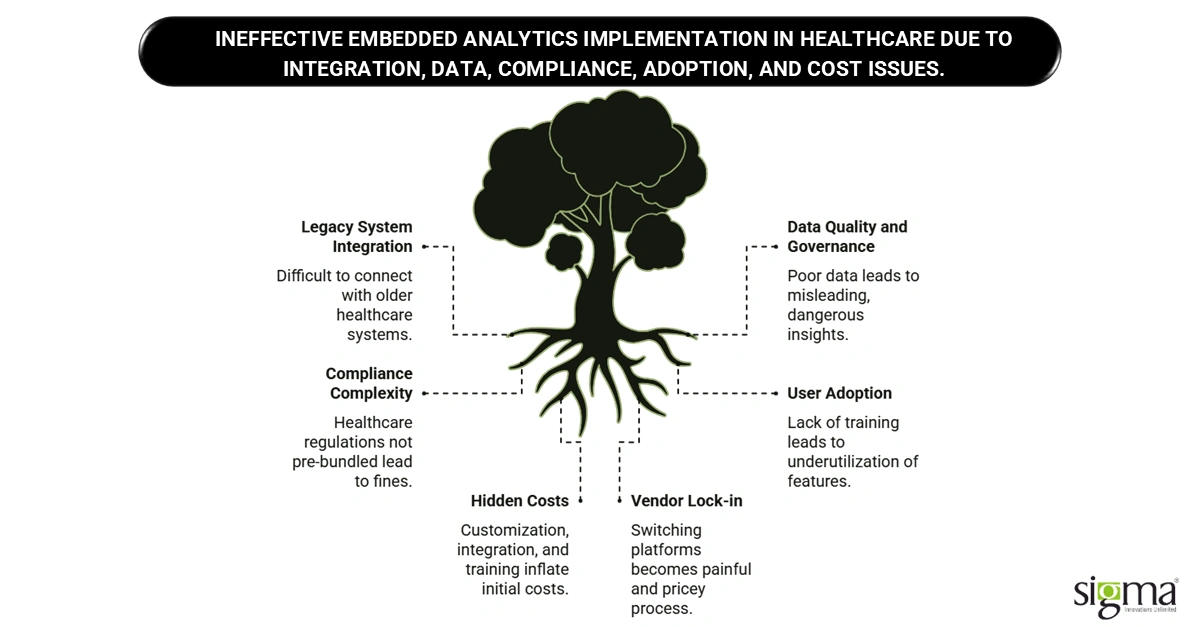
1. Integration with Legacy Systems: When Old Meets New
One of the biggest hurdles? Connecting embedded analytics solutions to older systems like EHRs or custom-built hospital platforms that weren’t designed with APIs in mind. These legacy systems can act like digital silos—making it tough to pull or push data in real time.
Unless healthcare providers invest in modern technology development services or tech consultancy services, analytics features risk being stuck in the slow lane or—worse—breaking things that were already working.
2. Data Quality and Governance: Garbage In, Garbage Out
Embedded data analytics is only as smart as the data it’s working with. If the data is incomplete, outdated, or poorly formatted, the insights will be misleading at best—and dangerous at worst.
From mismatched patient records to inconsistent medical coding, poor data governance can turn an insightful dashboard into a data disaster. This is where expert BI & Analytics development services and Artificial Intelligence data-cleaning models can help. But if overlooked, bad data = bad decisions.
3. Compliance Complexity: The Regulation Maze
Healthcare is a regulatory jungle. From HIPAA and HITRUST to CMS rules and state-level privacy laws, staying compliant is a full-time job. Add embedded analytics tools into the mix, and suddenly you’ve got to make sure visualizations, user access, and stored insights are all audit-ready.
Not every embedded analytics solution comes pre-bundled with this level of compliance. Skipping it can lead to hefty fines or operational shutdowns.
4. User Adoption: Great Tool, But Who’s Using It?
If clinicians and admins aren’t trained to interpret heatmaps, charts, or drill-down analytics, the best features can end up collecting dust. Visuals must be intuitive, role-based, and designed for workflows—otherwise adoption suffers.
5. Hidden Costs: The Budget Sinkholes
Finally, there’s the money side. While many embedded analytics tools advertise low-cost or “plug-and-play” options, real-world implementations often require:
- Customization
- Integration work
- Training
- Ongoing license fees
And let’s not forget the risk of vendor lock-in—where switching platforms later becomes a painful and pricey process.
So yes, embedded analytics is a powerful innovation. But without the right strategy, partner, and infrastructure, it can quickly go from a dream upgrade to a budget and operational headache.
Also Read: Tableau: Is It The Business Intelligence Solution For You?
Market Trends: Embedded Analytics in HealthTech and InsurTech
The embedded analytics market in healthcare isn’t just growing—it’s sprinting. Digital health and InsurTech startups are embracing embedded analytics solutions like essential tech gear in a high-stakes race. Whether they’re building MVPs or scaling up to Series B and beyond, these teams are weaving analytics into the core of their platforms from day one.
Why the rush? Simple. Investors, patients, and payers all want to see the impact—in real time.

VCs Are Betting Big on Data-Rich HealthTech
Venture capital firms aren’t just backing platforms that say they help patients—they’re funding startups that show it through clear, measurable outcomes. Real-time insights about patient adherence, health improvements, or insurance savings are major trust builders. Embedded data analytics not only supports transparency but also boosts valuations.
When analytics is baked into patient apps, provider dashboards, or claims systems, it gives stakeholders the confidence that decisions are driven by real data, not assumptions.
White-Labeled and Scalable = The New Standard
As healthcare SaaS expands, so does the need for white-labeled embedded analytics tools. Companies don’t want to reinvent the wheel—they want out-of-the-box, configurable dashboards that feel native to their own platform.
Think of it as renting a well-stocked kitchen instead of building one from scratch. Our BI & Analytics development services are seeing more demand for ready-to-integrate, fully brandable analytics modules—especially among B2B SaaS vendors targeting hospitals, insurers, or wellness platforms.
Where FinTech Meets HealthTech: Blurred Boundaries
The line between FinTech and HealthTech is fading fast. Embedded analytics use cases now cross industries:
- Cost forecasting for elective procedures
- Claims verification for fraud prevention
- Embedded credit options to finance surgeries or dental work
- KYC dashboards integrated into healthcare lending workflows
This convergence isn’t just logical—it’s a strategic necessity. Startups are turning to technology consulting services and Salesforce services to build connected systems that offer financial and medical insights under one roof.
And with IoT software development rising, wearable device data and health financing models are being analyzed side-by-side to create smarter, more personalized patient experiences.
In short, if your platform can measure it, prove it, and personalize it—you’re in demand. Embedded analytics has become a core value driver in both HealthTech and InsurTech.
How a Technology Services Partner Can Help
Let’s face it—building an embedded analytics solution that’s HIPAA-compliant, user-friendly, and scalable isn’t a walk in the park. Whether you’re a healthtech startup working on your MVP or a legacy provider modernizing your stack, there’s a lot to juggle. That’s where a trusted technology services partner comes in.
We help you plan the full architecture—from picking the right embedded analytics tools (like Looker, Qlik, or Power BI Embedded) to designing a HIPAA-ready backend that plays nicely with your existing EHRs or insurance systems. Need custom dashboards inside your patient app, provider portal, or claims platform? We’ve got you covered with tailored BI & analytics development services and technology development services built for healthcare.
And because we understand compliance, we know how to navigate tricky waters like HIPAA, SOC2, HITRUST, and even KYC or PCI-DSS compliance when finance meets care.
We’ve helped digital health platforms and insurtech players embed analytics that go beyond charts—it drives smarter decisions, improves care outcomes, and uncovers new business opportunities. From IoT development to artificial intelligence integration, we build solutions that help you get the most out of your data, without the tech headaches.
Ready to turn insights into impact? That’s what a smart tech consultancy service can do for you.
Conclusion – A Boon with the Right Partner
Embedded analytics isn’t just another feature—it’s a strategic asset when designed with the right intent, tools, and infrastructure. From clinical insights to patient engagement to insurance workflows, the value it brings can transform how healthcare operates and delivers care.
But here’s the kicker: shortcuts and off-the-shelf BI plugins can do more harm than good. Healthcare data is sensitive, and cookie-cutter solutions rarely check all the boxes—especially when it comes to compliance, scalability, or integration with complex EHR and FinTech systems.
That’s why working with a partner who understands both healthcare and finance is key. At Sigma Infosolutions, we bring deep expertise in embedded analytics solutions, technology consulting services, and FinTech software development services to help you build powerful, secure, and scalable analytics into your platforms.
Let’s connect and explore how our team can help your digital health business thrive with embedded analytics.
Frequently Asked Questions (FAQs)
1. How are embedded analytics tools different from traditional BI platforms?
Traditional BI tools require you to pull data into separate dashboards, often leading to delays and fragmented workflows. In contrast, embedded analytics tools deliver real-time, contextual insights directly within the app or workflow—reducing clicks, saving time, and improving decisions. For example, a care provider can see patient trends inside their EHR without switching tabs.
2. Can embedded data analytics help with HIPAA and regulatory compliance?
Yes, embedded data analytics can be built with role-based access controls, audit trails, and encryption standards that meet HIPAA, HITRUST, SOC2, and CMS mandates. At Sigma Infosolutions, we ensure our technology consulting services account for all major healthcare regulations during development.
3. How does embedded analytics benefit insurance and claims platforms?
For payers and insurtech platforms, embedded analytics solutions can detect fraud, automate claim verification, and optimize pricing using real-time data. It’s similar to how embedded credit scoring or KYC dashboards work in FinTech apps—but tailored for health economics.
4. Can Sigma Infosolutions build custom embedded analytics for our SaaS product?’
Absolutely. We offer BI & analytics development services that include custom dashboards, Artificial Intelligence-powered predictions, and integrations with tools like Power BI Embedded, Qlik, and Looker. Whether you’re in healthtech or fintech, our technology development services are designed to scale with your product.
5. What kind of healthcare startups or platforms benefit the most from embedded analytics?
Any digital health or insurtech platform that deals with patient data, treatment workflows, or policy claims can benefit. Especially if you’re in the MVP or scale-up stage, embedded analytics helps you impress stakeholders and optimize user experience right from the start.
6. Why should we choose Sigma Infosolutions as our embedded analytics partner?
Because we combine strong healthcare domain knowledge with proven success in FinTech software development services and IoT software development. We don’t just plug in charts—we architect, customize, and secure end-to-end embedded analytics experiences with scalable cloud, AI, and tech consultancy service support.